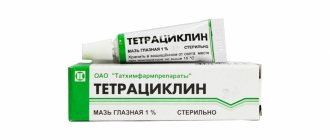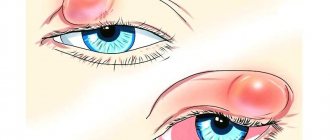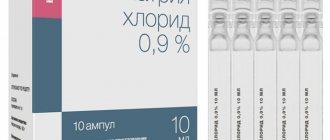- Types of edema and causes of development
- Swelling that may look like angioedema
- Symptoms
- Diagnostics
- Treatment
- First aid for Quincke's edema
- Prevention
Angioedema (Angioedema) is a condition in which fluid from small blood vessels enters the tissue, causing swelling. The reason for such a reaction in some cases is allergens (allergies), upon contact with which the body produces immunoglobulin and releases histamine into the blood. Up to 20% of people at some point in their lives experience urticaria (cap-shaped swellings on the surface of the skin) and only one in three experience Quincke's edema.
Types of edema and causes of development
- Acute allergic angioedema. Almost always accompanied by urticaria, which occurs within 1-2 hours after contact with the allergen. This reaction can be caused by nuts, shellfish, milk, eggs, insect poison, latex products - medical gloves, balloons and catheters.
- Hereditary angioedema (HAE). A genetic disease of the immune system in which there is a deficiency of C1-esterase inhibitor. This rare phenomenon occurs in one in 50 thousand people.
- Idiopathic. It is impossible to identify the allergen or causes of swelling. Doctors classify as idiopathic edema those cases where there is no clear etiology.
- Viral. It most often occurs in children whose immune systems are not resistant to the effects of a number of viruses. The swelling subsides within 24 hours.
- Induced. It occurs while taking antimicrobial agents, drugs for treating high blood pressure, and over-the-counter nonsteroidal anti-inflammatory drugs for pain and fever. About 30% of cases of edema, according to statistics, occur with ACE inhibitors (angiotensin-converting enzyme), which are used in the treatment of heart and kidney failure, as well as to lower blood pressure.
Causes
Quincke's edema is the body's response to an allergen. The following substances and agents may be the cause:
- toxins and poisons, incl. insects;
- dust;
- animal hair and dander;
- microorganisms - fungi, bacteria and even viruses;
- chemicals such as turpentine and phenol;
- latex products;
- plant pollen;
- medications: anesthetics, bromides, iodine, immunoglobulins, B vitamins, antihypertensives, antibiotics;
- substances contained in eggs, nuts, milk, fish, honey, citrus fruits, strawberries or chocolate;
- food colors, flavors, flavor enhancers, preservatives;
- artificial formula for babies.
Indirect factors that provoke angioedema include endocrine diseases and infection with worms. In people with hereditary allergies, swelling can be triggered by hypothermia or stress. A severe allergic reaction is insidious in that it can develop not during the first contact with the agent, but during the next one.
Edema that resembles Quincke's edema
A number of edemas only look like angioedema, but have a completely different etiology from it:
- Contact allergies to animals, plants and some types of insects (wasps, ants, bees) are usually localized at the site of direct contact. Accompanied by short-term itching and a slight rash. Symptoms go away on their own after a few days.
- Severe hay fever (allergic rhinitis) or asthma.
- Palindromic rheumatoid arthritis. Swelling occurs over the affected joint; in some cases, the entire limb swells. The swollen area is very painful and itchy for a long time.
- Dermatomyositis is muscle weakness resulting from damage to striated muscle tissue. Redness is accompanied by swelling of the face.
- Superior vena cava syndrome in the chest leads to regular accumulation of fluid in the neck, face and arms.
- Hypothyroidism is a disorder in the production of thyroid hormones. Provokes swelling of the face and lips.
- Subcutaneous emphysema is a “leakage” of air into soft tissues, often occurring after injury or surgery.
- Cluster headache is a series of pronounced painful attacks localized in one area.
- The syndrome is accompanied by swelling around the eye from the affected area.
Symptoms
- Local burning in the affected area.
- Pain, itching, redness.
- Hives.
- Peripheral edema of the skin and urogenital area.
- Abdominal pain.
- Rapid heartbeat, as if intoxicated.
- Nausea and vomiting.
- Decreased appetite.
- Feeling of constriction in the larynx.
- Voice deformation, characteristic hoarseness.
- Labored breathing.
- Swelling of the tongue and lips, sometimes so severe that the tongue cannot fit in the mouth.
Quincke's edema (other names - acute angioedema, giant urticaria, trophoneurotic edema, angioedema) is a suddenly developing limited or diffuse edema of subcutaneous fatty tissue and mucous membranes. Both adults and children are susceptible to Quincke's edema, but the disease most often occurs at a young age, especially in women. Rarely observed in children and elderly people.
Allergic edema based on an allergic antigen-antibody reaction. Biologically active substances - mediators (histamine, kinins, prostaglandins) released in a previously sensitized body cause local dilation of capillaries and veins, an increase in microvascular permeability occurs and tissue edema develops. The cause of allergic edema may be exposure to specific foods (eggs, fish, chocolate, nuts, berries, citrus fruits, milk), medications and other allergens (flowers, animals, insect bites).
In patients with non-allergic Quincke's edema, the disease is caused by heredity. Inheritance occurs according to the dominant type. The level of C-esterase inhibitors and kallikrein was reduced in the serum of patients. In this case, angioedema, similar to allergic edema, develops under the influence of substances that cause the formation of histamine - the same allergens. Edema develops in a sensitized body under the influence of specific allergens: flowers, animals, food, drugs, cosmetics or nonspecific: stress, intoxication, infections, hypothermia. Predisposing factors may be diseases of the liver, thyroid gland (especially with its reduced function), stomach, blood diseases, autoimmune and parasitic diseases. Often in this case the disease takes on a chronic relapsing course.
In some cases, the cause of Quincke's edema cannot be determined (so-called idiopathic edema).
Symptoms of Quincke's edema:
The disease begins suddenly. Within a few minutes, less often hours, pronounced swelling develops in different parts of the face and mucous membranes. Local swelling of the lips, eyelids, scrotum, as well as the mucous membranes of the oral cavity (tongue, soft palate, tonsils), respiratory tract, gastrointestinal tract, and genitourinary area may be observed. Swelling is rarely accompanied by pain; more often, patients complain of a feeling of tissue tension. In the area of edema, tension in the tissues of elastic consistency is noted; with pressure, no pit remains; palpation (feeling) of the swelling is painless.
Most often, Quincke's edema is located on the lower lip, eyelids, tongue, cheeks, larynx, and swelling of the larynx and tongue can lead to the development of asphyxia - difficulty breathing occurs, aphonia, and cyanosis of the tongue develop.
When edema spreads to the brain and meninges, neurological disorders appear (epileptiform seizures, aphasia, hemiplegia, etc.).
Quincke's edema can last for several hours or days, then disappears without a trace, but can periodically recur.
Complications of Quincke's edema:
The most threatening complication may be the development of laryngeal edema with increasing symptoms of acute respiratory failure. Symptoms of laryngeal edema include hoarseness, barking cough, and progressive difficulty breathing.
Swelling of the gastrointestinal mucosa can simulate acute abdominal pathology, and dyspeptic disorders, acute abdominal pain, increased intestinal motility, and sometimes symptoms of peritonitis can be observed.
Damage to the urogenital system is manifested by symptoms of acute cystitis and can lead to the development of acute urinary retention.
The most dangerous localization of edema is on the face, since the meninges may be involved in the process with the appearance of meningeal symptoms or labyrinthine systems, which is manifested by signs of Meniere's syndrome (dizziness, nausea, vomiting). In the absence of urgent qualified assistance, such swelling can lead to death.
A combination of acute urticaria and Quincke's edema is possible.
Diagnosis of Quincke's edema:
Differential diagnosis is carried out with lymphostasis, collateral edema during periostitis, erysipelas, Melkerson-Rosenthal syndrome. In Melkerson-Rosenthal syndrome, along with chronic swelling of the lip, folded tongue and neuritis of the facial nerve are detected. With erysipelas of the lip, there is hyperemia (redness) in the affected area in the form of flames.
Emergency care for Quincke's edema:
- When blood pressure decreases, 0.1–0.5 ml of a 0.1% adrenaline solution is injected subcutaneously;
- For asphyxia (swelling of the mucous membrane of the respiratory tract), adrenaline injections;
- Hormonal therapy: glucocorticoids (prednisolone 60-90 mg IM or IV; dexazone 8-12 mg IV;)
- Desensitizing treatment: antihistamines (Suprastin 2% - 2.0 IM, Claritin, Zyrtec, Erius, Telfast).
- Diuretics: Lasix 40-80 mg IV in 10-20 ml saline solution;
- Protease inhibitor drugs: contrical - 30,000 units IV in 300 ml of saline, epsilon-aminocaproic acid 5% - 200 ml IV drip, then 100 ml after 4 hours or 4 g per os 4-5 times a day the day until the reaction is completely relieved;
- Detoxification therapy - hemosorption, enterosorption;
- Hospitalization in the allergy department.
Treatment of Quincke's edema:
- Eliminating contact with the allergen;
- prescribing drugs to increase the tone of the sympathetic nervous system (calcium preparations, ascorbic acid, ephedrine);
- decrease in parasympathetic activity (atropine) and histamine levels (diphenhydramine, suprastin, tavegil);
- Vitamin therapy is necessary - ascorutin is prescribed to reduce vascular permeability;
- Desensitizing therapy (ACTH, cortisone, prednisolone) and a course of treatment with B vitamins and gamma globulin are indicated
- The basis for the treatment of the hereditary form of Quincke's edema are medications that enhance the production of the missing C1 inhibitor in the body.
Treatment with hormones in the absence of contraindications to hormone therapy is recommended to be carried out in a hospital.
Prevention of Quincke's edema:
The only reasonable prevention is to avoid contact with allergens.
Diagnostics
In some cases, a doctor can diagnose angioedema based on the medical history and characteristic clinical manifestations, without performing additional tests. In chronic and recurrent cases without a known “trigger” (what causes the tissue to swell), a series of tests are prescribed to help determine the cause.
To determine the cause of the disease, laboratory and hardware diagnostic methods are used:
- Complete blood count with differential - shows the number and types of leukocytes in the blood.
- Erythrocyte sedimentation rate (ESR) is a common blood test used to detect and monitor inflammatory conditions.
- The D-dimer level is an indicator of the intensity of blood clot formation.
- General urinalysis – screening and assessment of diseases and infections in the genitourinary system.
- A comprehensive metabolic profile is a screening of general health and includes about 70 indicators.
- Testing for antinuclear antibodies and CH50 level - identifies autoimmune pathologies in the body.
- Thyroid studies, including thyroid-stimulating hormone levels.
- Testing for hepatitis B and C viruses.
- Rheumatoid factor.
- Cryoglobulin levels.
- X-ray and ultrasound of the abdominal cavity - to identify possible ascites.
- Computed tomography scan of the abdomen reveals swelling of the intestinal wall.
Types of edema.
There are several types of Quincke's edema.
Angioedema can be hereditary or acquired. Hereditary angioedema is a rare genetic disease that was first described at the end of the 19th century and is characterized by recurrent edema. If a mother or father has this diagnosis, the probability that their child will be born with the same diagnosis is 50%. With timely prevention and proper treatment, the patient’s attacks rarely occur, and the patient lives quite well with this diagnosis. Cases of acquired disease are quite small, and are most often observed in elderly patients.
Depending on the cause that caused Quincke's edema, allergic, non-allergic and idiopathic edema are distinguished when the cause of the condition could not be determined.
Treatment
In mild cases of the disease - swelling with urticaria - antihistamines partially relieve itching and reduce swelling. Oral corticosteroids are prescribed for severe symptoms when other treatments are ineffective. The course of administration is no more than 3-4 weeks: the drug provokes severe side effects. Topical corticosteroids, such as ointments, creams, lotions, do not help.
For swelling without urticaria, standard drug treatment does not help. If the cause is an angiotensin-converting inhibitor (ACEI), symptoms usually resolve within 24 to 48 hours after stopping the drug. If symptoms persist and the condition worsens, your doctor may prescribe fresh frozen plasma, purified C1 inhibitor obtained from human blood, or hypoglycemic drugs. For idiopathic angioedema, the person should be given a large dose of an antihistamine intravenously/intramuscularly.
Cost of consultation?
| Name of service | Price, rub.) |
| Initial appointment with a dermatologist | 2000 rub. |
| Repeated appointment with a dermatologist | 1500 rub. |
| Primary appointment with a general practitioner | 2000 rub. |
| Repeated appointment with a general practitioner | 1500 rub. |
| Prescription of treatment (drawing up an individual treatment regimen) | 1500 - 3000 rub. |
All our services and prices
First aid for Quincke's edema
Severe angioedema causes difficulty breathing and swallowing, and one or both of the following should be done immediately:
Seek emergency medical help
- inject adrenaline under the skin or into a muscle;
- insert a breathing tube through the nose or mouth into the windpipe (intubation).
In cases where the airway closes too quickly, a tracheotomy is performed - a small incision is made in the skin above the trachea, then a breathing tube is inserted.
People with severe reactions should always carry a self-injection syringe with them. Antihistamine tablets may also help, but you will still need to administer adrenaline first.
Where to get tested for allergic diseases in Moscow?
In a multidisciplinary medical center you can always undergo examination, prevention and treatment of allergic diseases
. Our medical center is located between the Konkovo and Belyaevo metro stations (South-Western Administrative District of Moscow in the area of the Belyaevo, Konkovo, Teply Stan, Chertanovo, Yasenevo, Sevastopolskaya, New Cheryomushki metro stations " and "Trade Union"). Here you will find highly qualified personnel and the most modern diagnostic equipment. Our clients will be pleasantly surprised by our quite affordable prices.






